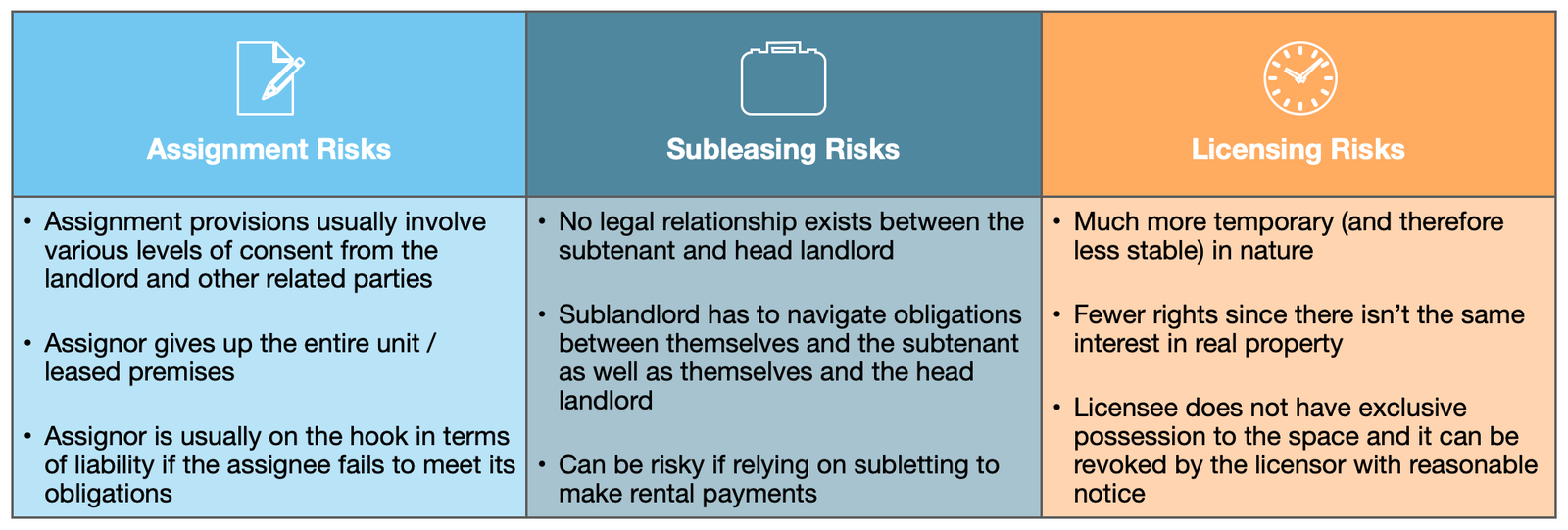Please click here to read Part 1: https://realstrategy.com/commercial-real-estate-subleasing-for-beginners/
Assignments
When a tenant decides to assign a lease, they are essentially giving up the space and all their rights and responsibilities to the rental agreement to a third-party assignee. In these cases, the assignee will usually work directly with the landlord and will take on all the obligations under the original lease basically becoming the new tenant. The old tenant is not involved anymore except that they’re often required to maintain some sort of liability if the assignee fails to meet the terms of the lease or defaults.
Subletting
Subleasing, on the other hand, is when a subtenant takes over a piece of or the entire space and the original tenant then plays the role of the sublandlord. The sublandlord and landlord maintain a relationship in this context because the original tenant still has to adhere to the obligations of the headlease (i.e. the primary lease).
The sublandlord also has obligations to the subtenant under the sublease. The major point to note here is that the sublease has to be for a shorter term than the headlease. It’s a very specific legal point that can make a really big difference but if the sublease term extends past the headlease’s, it can actually be deemed an assignment.
Licensing
Licensing, while separate, is related to subletting in that it still involves the occupation of space, but licenses are not leases. With leasing, tenants have the right to exclusive possession of the premises, whereas licensing is a separate form of property interest where the right to non-exclusive use of space is merely granted.
A common example of this practice is the vendor carts and stations in malls. These vendors don’t have the exclusive right to that space in the middle of the walkway and are simply licensing it. Since there is not a lease or exclusive possession, licensees have fewer rights associated with the space.
“It’s a very good idea for tenants, in particular, to seek legal counsel because the differences between these situations can have huge impacts on their responsibilities and liabilities.” — Vanessa Carment (Associate Lawyer, Soloway Wright LLP)

Negotiating subleases and provisions in the current climate
Since more organizations are interested in subleasing, one of the main areas to be concerned with is indemnity and mutual releases between relevant parties. In other words, you’ll want your subleasing provisions to account for cases where the subtenant does something that messes up the property or removes chattels and fixtures for example. Make sure to have clear obligations and requirements for the subtenant in this case so that you (as sublandlord) are not left responsible to the head landlord and that the subtenant is.
Speaking more to the recent situation of the pandemic, people are really looking at force majeure. Force majeure was considered a boilerplate clause for the longest time that wasn’t acted on very often. It sets out certain situations that may impede a party’s ability to meet their obligations under the lease and has classically included things like acts of war and strikes. It usually excludes payment of rent but sometimes it doesn’t. Nowadays, everybody is including phrases such as pandemics, epidemics, public health emergencies, government orders, and any sort of language that’s adjacent to what’s been experienced with COVID-19.
“The thing to consider with force majeure is that the specific language is extremely important. If you say pandemic and the situation that arises isn’t declared as such, then the court may side with the landlord since it wasn’t technically a pandemic.” — Vanessa Carment (Associate Lawyer, Soloway Wright LLP)
People are now including certain provisions surrounding various emergencies that guarantee specific rights and requests. For example, the landlord might be required to provide a certain amount of health-related measures for the building and occupants, such as sanitizing surfaces more often. Although not a popular practice, you could in theory put in a provision where the subtenant is also entitled to sublease in certain situations. If the original tenant finds themselves in a sublandlord position and is concerned that the subtenant may not be able to meet their financial obligations, they may want to have an out in the form of a sub-sublease.
Really, it all goes back to the negotiating power that exists between the parties and the larger context at hand. With the record vacancy being observed, especially with office buildings, landlords are more receptive to reducing their requirements and broadening their horizons to increase occupancy in their buildings. Likewise, if a tenant is looking for a subtenant in a very competitive market, they may want to reduce the amount of rent payable under the sublease, or offer free rent as an alternative to cash inducements typically used to offset construction costs of the incoming tenant.
Negotiating with flexibility in mind and offering discounts is also a great way to make space enticing for potential tenants. At the end of the day, making some profit or at least breaking even is more attractive than going further into the hole. It’s really about the recovery of your contracted liability, which is a fancy way of saying how much you would continue to pay the landlord if you honoured the terms of your lease. Generally in a sublease, we at Real Strategy Advisors feel that anywhere from 50% – 75% recovery is considered good.
Contact Real Strategy Advisors today so we can discuss your organization’s back-to-work strategy and how to take advantage of this historic market opportunity.
Soloway Wright is a regional law firm with offices in Ottawa and Kingston. The law firm offers a dynamic blend of knowledge and experience to clients requiring assistance with Real Estate, Business, Commercial Litigation and Leasing, Personal Injury, Medical Malpractice, Planning and Land Development, Employment and Labour, and Estate Planning and Administration law matters.

